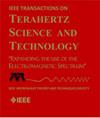D- and G-Band Correlating Radiometers
IF 3.9
2区 工程技术
Q2 ENGINEERING, ELECTRICAL & ELECTRONIC
IEEE Transactions on Terahertz Science and Technology
Pub Date : 2024-11-07
DOI:10.1109/TTHZ.2024.3492997
引用次数: 0
Abstract
Correlating radiometers are presented at D-band (100–120 GHz) and G-band (160–185 GHz). The D-band system is a heterodyne receiver focused around the 118.75 GHz oxygen line and the G-band system is a direct-detection pseudocorrelating receiver focused around the 183.31 GHz water-vapor line. These systems are integrated into multiple waveguide blocks to facilitate troubleshooting and to enable different RF filters to be applied to the low noise amplifier (LNA)-based front ends. Discussion of the data-processing is presented for both systems. The D-band system has a noise temperature of 410 K at 120 GHz. The correlated output of this system increased the Allan time from 100 ms to 7 s. The G-band system has an average noise temperature of 780 K, with an increase in Allan time from 1 ms to 10 s.D波段和g波段相关辐射计
相关辐射计分别在d波段(100-120 GHz)和g波段(160-185 GHz)提出。d波段系统是聚焦在118.75 GHz氧线附近的外差接收机,g波段系统是聚焦在183.31 GHz水蒸汽线附近的直接探测伪相关接收机。这些系统集成到多个波导模块中,以方便故障排除,并使不同的RF滤波器应用于基于低噪声放大器(LNA)的前端。讨论了两种系统的数据处理。d波段系统在120 GHz时噪声温度为410 K。该系统的相关输出将艾伦时间从100 ms提高到7 s。g波段系统的平均噪声温度为780 K,艾伦时间从1 ms增加到10 s。
本文章由计算机程序翻译,如有差异,请以英文原文为准。
求助全文
约1分钟内获得全文
求助全文
来源期刊

IEEE Transactions on Terahertz Science and Technology
ENGINEERING, ELECTRICAL & ELECTRONIC-OPTICS
CiteScore
7.10
自引率
9.40%
发文量
102
期刊介绍:
IEEE Transactions on Terahertz Science and Technology focuses on original research on Terahertz theory, techniques, and applications as they relate to components, devices, circuits, and systems involving the generation, transmission, and detection of Terahertz waves.
 求助内容:
求助内容: 应助结果提醒方式:
应助结果提醒方式:


